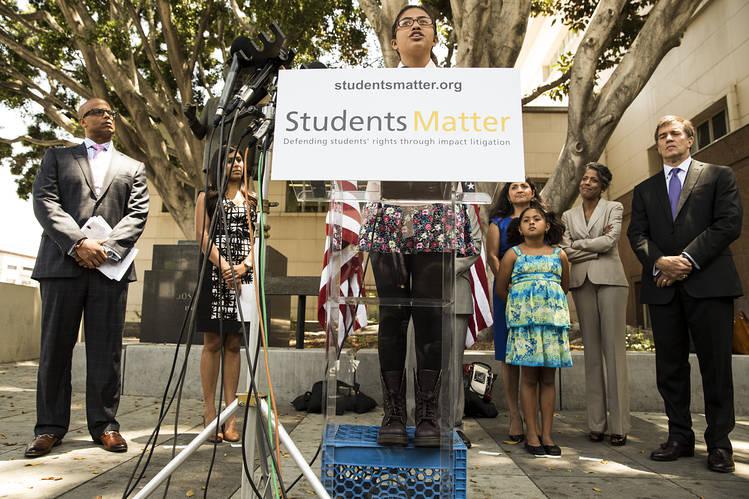
The California Supreme Court announced Aug. 22 that it would not hear Vergara v. California, a landmark case fighting for the educational rights of public-school students. The court’s unwillingness even to consider an issue that Justice Goodwin Liu called “one of the most consequential to the future of California” demonstrates why the federal courts must intervene and recognize that the U.S. Constitution guarantees a fundamental right to education.
In Vergara, nine students challenged teacher-tenure and dismissal laws that make it nearly impossible for school districts to remove grossly ineffective teachers from the classroom. We were part of the team, along with our partner former U.S. Solicitor GeneralTheodore Olson, who represented the student plaintiffs. After an eight-week bench trial in 2014, Los Angeles County Superior Court Judge Rolf Treu struck down the statutes under the state constitution because their twisted logic is “unfathomable” and they inflict harm so severe that it “shocks the conscience.”
Judge Treu’s decision attracted national attention. Then-Education Secretary Arne Duncan declared that the decision “presents an opportunity for a progressive state with a tradition of innovation to build a new framework for the teaching profession that protects students’ rights to equal educational opportunities while providing teachers the support, respect and rewarding careers they deserve.”
The state of California and California’s two largest teachers unions appealed. In its decision, the California Court of Appeal acknowledged that the laws are a “problem,” agreed that they likely lead to “grossly ineffective teachers being in the educational system,” and described the situation as “deplorable.” The court sided with the unions anyway.
The case seemed destined for the California Supreme Court, but on Aug. 22 the court declined to hear the case by a vote of 4-3. Pursuant to its ordinary procedures, the court did not explain why. Yet two justices took the extraordinary step of issuing dissenting opinions decrying the majority’s failure to act. Justice Liu wrote that “[t]he nine schoolchildren who brought this action, along with the millions of children whose educational opportunities are affected every day by the challenged statutes, deserve to have their claims heard by this state’s highest court.” Justice Mariano-Florentino Cuéllardescribed the laws as “staggering failures that threaten to turn the right to education for California schoolchildren into an empty promise.”
California’s refusal to protect its young citizens has made federal protection essential. Public education meets the U.S. Supreme Court’s fundamental-right test, as articulated inWashington v. Glucksberg (1997), because it is “deeply rooted in this Nation’s history and tradition” and “implicit in the concept of ordered liberty.” Laws that impair that right should be subject to strict scrutiny under the Constitution’s due-process and equal-protection clauses.
Public education has been a fundamental pillar of U.S. society since the nation’s founding, when the Continental Congress set aside public lands “to support a system of schools in a state.” As the Supreme Court put it in 1954’s historic Brown v. Board of Education ruling: “it is doubtful that any child may reasonably be expected to succeed in life if he [or she] is denied the opportunity of an education.”
Two decades after Brown, the Supreme Court in San Antonio Independent School District v. Rodriguez (1973) held that education is not a fundamental right in the context of school funding. But it expressly left open the possibility that a right to education might be recognized in another situation. In Papasan v. Allain (1986), the court made clear that whether education is a fundamental right is “not yet definitively settled.”
Such a right would not be an open invitation for federal courts to manage schools or for litigants to bring every education policy question to federal court. Rather, it would protect children across the country against state laws and policies that actively and knowingly deprive them of essential educational opportunities and create egregious inequality, like the California statutes in Vergara.
The day after the denial of review in Vergara, we filed a case in Connecticut federal court,Martinez v. Malloy. We argue for a federal constitutional right to challenge laws that force inner-city children to attend schools that the state knows are failing to provide a minimally acceptable education. These laws are especially cruel because Connecticut has some terrific public schools, including in urban centers.
Magnet schools and public charter schools achieve outstanding results for students. Yet Connecticut has defied reason and imposed a moratorium on magnet schools and an effective cap on charter schools. The state also punishes high-quality public schools that accept transfer students from failing schools. Inner-city kids have to win a lottery to gain access to decent schools.
In Brown, the Supreme Court described education as the “very foundation of good citizenship,” and proclaimed that the “opportunity of an education . . . is a right which must be made available to all on equal terms.” The federal courts should transform these powerful words into a reality and enforce the fundamental right of children to education in this country.
Source: The Wall Street Journal
 FR
FR EN
EN AR
AR








